The pull to the left on my K16GTL was significant enough that I would not be able to "just live with it." So I started considering the options.
Assuming the pull is caused by the center of mass of the bike not being directly over the line between the tire contact patches, one of the tires needs to move laterally. On my 1999 R11RT, I had a right pull that was cured by moving the swingarm 2 mm to the right.
On my K16GTL, the swingarm cannot move any further to the left. So I started thinking about how to move the front wheel to the right. That means either (i) shifting the wheel relative to the wheel carrier (not possible); (ii) shifting the lower A-arm to the right; (iii) shifting the upper A-arm to the left (moving to the left causes the wheel carrier to move to the right, pivoting about the lower ball joint).
The upper A-arm is mounted on two pivot bolts: the one on the left is a fixed pivot bolt (#7):
![Image]()
The right pivot is a pivot pin (#5) with a lock nut (#6). I took a look up the nose, and saw there were several threads-depth of left-moving room left on the upper A-arm -- so the chance of moving the upper A-arm was there.
The next question was: How is the access to the left and right ends of the pivots? The answer was: Good -- once the fuel tank is removed, it is a straight shot to both ends (the nose extensions of the tank exactly cover the pivots). The lower A-arm pivots are buried under much equipment.
Left upper:
![Image]()
Right upper:
![Image]()
So, the obvious answer was to remove the left pivot bolt, place some shims under the bolt, and drive the right pivot pin further in to drive the A-arm to the left.
Before removing the left pivot, you need to support the bike, so that the fork/A-arm/frame arrangement don't shift when the pivot is removed. I used a small jack under a piece of wood under the front of the headers, in front of the cat converters:
![Image]()
![Image]()
Adjust the jack so that the front tire is just touching -- i.e., so the bike weight load on the front tire is just "neutral" so the upper A-arm does not want to shift front/back when the left pivot bolt is removed.
Note the upper A-arm is not a bike weight load-bearing component in the Hossack design -- weight is carried between the lower arm and the frame via the shock. However, the upper arm locates the top end of the wheel carrier (the non-telescoping fork) and therefore can see small fore-aft forces.
After setting up the jack, insert a 12 mm Allen bit into the left pivot bolt and loosen. Mine "popped" loose suddenly at ~70-80 ft-lbs of torque. No Locktite (actually, some anti-seize on the pivot's bearing-seat section):
![Image]()
The right pivot pin is held by a 30 mm lock nut; once loose, the 12 mm Allen bit can be used to advance the right pivot pin to the left.
![Image]()
So how to move the left pivot pin to the left, given that it is fixed by resting its head against the frame? By placing shims under the bolt head.
The first attempt at this fix I installed one 1.03 mm shim:
![Image]()
Not enough pull reduction with one shim, so I ended up using 4 shims (just a hair over 5 mm thickness,which translates into roughly a 15 mm shift to the right of the tire contact patch):
![Image]()
The "shims" are washers from the local hardware store -- 1" ID by 1 1/4" OD. 1" ID is too small to get over the left pivot bolt threads (the threads are 25.8 mm, so a 1"=25.4 mm washer won't fit), so they have to be opened up (I used a grinding stone). You could use a 1 1/8" ID washer, but I could not find one that had a small enough OD to fit within the machined recess of the left pivot.
Note: As I understand it, the bearings in the A-arm are ball bearings, which do NOT like axial loading. [[EDIT: The MaxBMW fiche sez they are angular-contact ball bearings -- so a little more tolerant of axial loads -- but not much.]] So after reinstalling the left pivot bolt, advance the right pivot, but don't apply much torque (6-7 Nm should be sufficient). I do NOT have the proper torque values for the left pivot bolt and the right lock nut (my dealer's service dept. doesn't have them yet). I re-torqued these to approximately what it felt like I needed to loosen them, keeping in mind the left pivot bolt is Aluminum, going into an Aluminum frame -- in other words, tight, but not gorilla-thread-stripping tight. Once I find the correct torque levels, I'll post them. In the meantime, I have marked the position of the components with paint to be able to tell whether they have loosened.
Hope this helps!
Mark
Assuming the pull is caused by the center of mass of the bike not being directly over the line between the tire contact patches, one of the tires needs to move laterally. On my 1999 R11RT, I had a right pull that was cured by moving the swingarm 2 mm to the right.
On my K16GTL, the swingarm cannot move any further to the left. So I started thinking about how to move the front wheel to the right. That means either (i) shifting the wheel relative to the wheel carrier (not possible); (ii) shifting the lower A-arm to the right; (iii) shifting the upper A-arm to the left (moving to the left causes the wheel carrier to move to the right, pivoting about the lower ball joint).
The upper A-arm is mounted on two pivot bolts: the one on the left is a fixed pivot bolt (#7):

The right pivot is a pivot pin (#5) with a lock nut (#6). I took a look up the nose, and saw there were several threads-depth of left-moving room left on the upper A-arm -- so the chance of moving the upper A-arm was there.
The next question was: How is the access to the left and right ends of the pivots? The answer was: Good -- once the fuel tank is removed, it is a straight shot to both ends (the nose extensions of the tank exactly cover the pivots). The lower A-arm pivots are buried under much equipment.
Left upper:
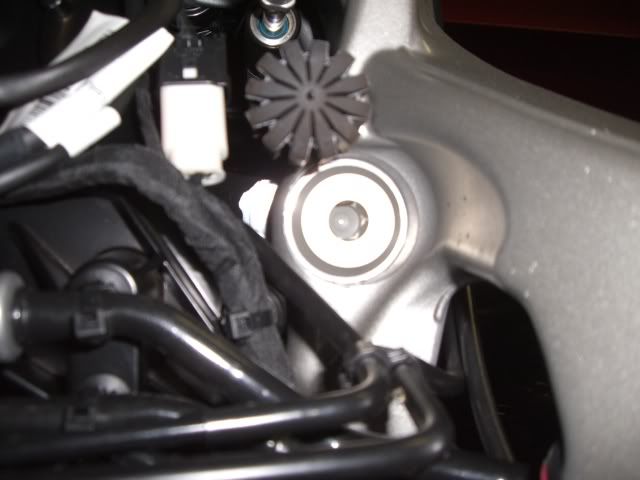
Right upper:
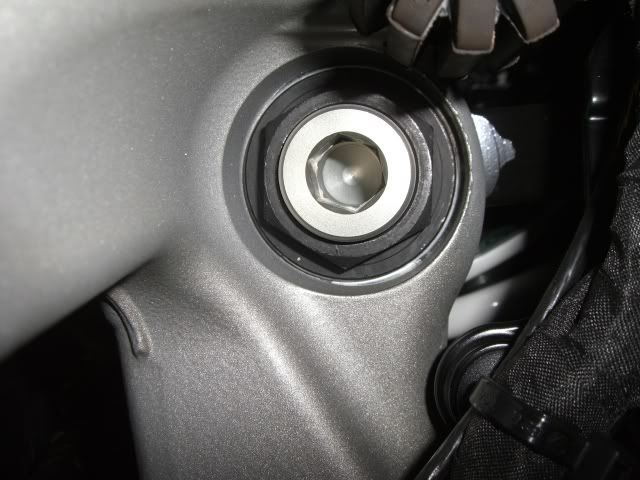
So, the obvious answer was to remove the left pivot bolt, place some shims under the bolt, and drive the right pivot pin further in to drive the A-arm to the left.
Before removing the left pivot, you need to support the bike, so that the fork/A-arm/frame arrangement don't shift when the pivot is removed. I used a small jack under a piece of wood under the front of the headers, in front of the cat converters:
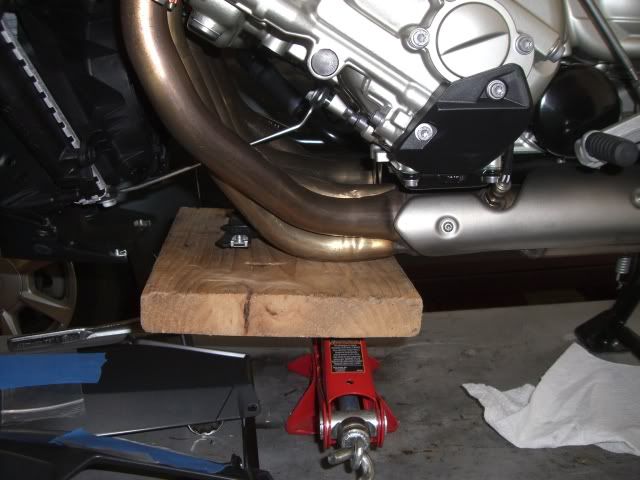
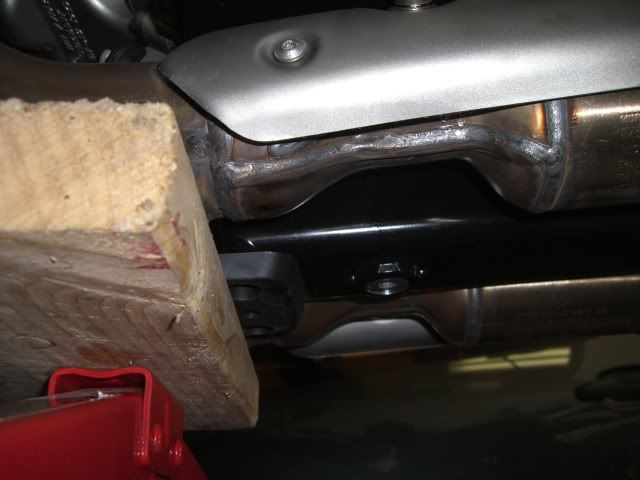
Adjust the jack so that the front tire is just touching -- i.e., so the bike weight load on the front tire is just "neutral" so the upper A-arm does not want to shift front/back when the left pivot bolt is removed.
Note the upper A-arm is not a bike weight load-bearing component in the Hossack design -- weight is carried between the lower arm and the frame via the shock. However, the upper arm locates the top end of the wheel carrier (the non-telescoping fork) and therefore can see small fore-aft forces.
After setting up the jack, insert a 12 mm Allen bit into the left pivot bolt and loosen. Mine "popped" loose suddenly at ~70-80 ft-lbs of torque. No Locktite (actually, some anti-seize on the pivot's bearing-seat section):
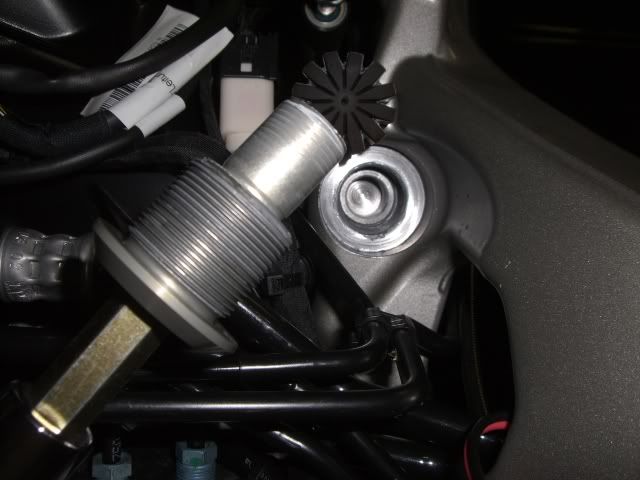
The right pivot pin is held by a 30 mm lock nut; once loose, the 12 mm Allen bit can be used to advance the right pivot pin to the left.

So how to move the left pivot pin to the left, given that it is fixed by resting its head against the frame? By placing shims under the bolt head.
The first attempt at this fix I installed one 1.03 mm shim:
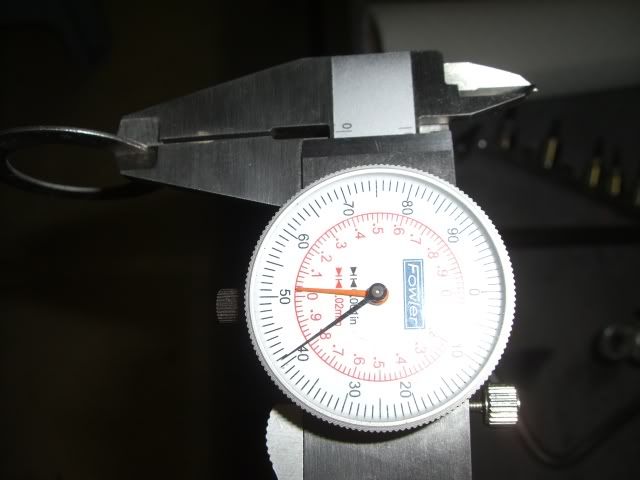
Not enough pull reduction with one shim, so I ended up using 4 shims (just a hair over 5 mm thickness,which translates into roughly a 15 mm shift to the right of the tire contact patch):
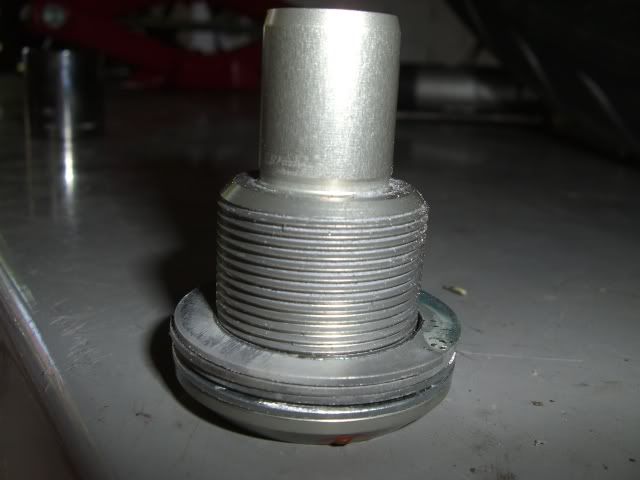
The "shims" are washers from the local hardware store -- 1" ID by 1 1/4" OD. 1" ID is too small to get over the left pivot bolt threads (the threads are 25.8 mm, so a 1"=25.4 mm washer won't fit), so they have to be opened up (I used a grinding stone). You could use a 1 1/8" ID washer, but I could not find one that had a small enough OD to fit within the machined recess of the left pivot.
Note: As I understand it, the bearings in the A-arm are ball bearings, which do NOT like axial loading. [[EDIT: The MaxBMW fiche sez they are angular-contact ball bearings -- so a little more tolerant of axial loads -- but not much.]] So after reinstalling the left pivot bolt, advance the right pivot, but don't apply much torque (6-7 Nm should be sufficient). I do NOT have the proper torque values for the left pivot bolt and the right lock nut (my dealer's service dept. doesn't have them yet). I re-torqued these to approximately what it felt like I needed to loosen them, keeping in mind the left pivot bolt is Aluminum, going into an Aluminum frame -- in other words, tight, but not gorilla-thread-stripping tight. Once I find the correct torque levels, I'll post them. In the meantime, I have marked the position of the components with paint to be able to tell whether they have loosened.
Hope this helps!
Mark





